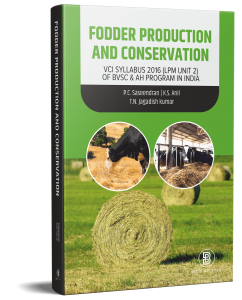About the Book
Fodder production and conservation is Unit 2 of Livestock Production Management course under VCI syllabus for the B.V.Sc., & AH program in India. The book is intended to provide in depth knowledge on the production, processing and conservation of fodder for livestock production. The entire syllabus was divided into seven chapters.
Chapter one is about the “Importance of grassland and fodder on livestock production”. The chapter deals with the status of geographical share of grassland, supply and demand of grass and types of grasslands in India. Chapter two “Agronomic practices for fodder production” discussed the cultivation protocols for
optimum fodder output.
Chapter three has listed out “Important leguminous and non leguminous fodders in different seasons” including its origin, varieties, soil requirements and yield.
Chapter four dealt with “soil and water conservation for fodder production” . Construction of terrace, bunds, trenches, ditches etc were discussed along with water conservation and storage.
Chapter five discussed about “Recycling of animal wastes and washing and use of recycle waste for fodder production”. In the chapter an attempt has been made to describe about the estimation of solid and liquid waste, its composition and processing for the use of fodder production.
Chapter six on “Forage production systems for small livestock units” has listed out various systems under irrigated, rain fed, problem soil and niche areas.
Chapter seven described about “Structures for storage of feed and fodder” which included concentrate feed, green fodder, dry fodder and scarcity fodder.
We the authors have taken utmost care to provide an exhaustive knowledge on the subject discussed in each chapter.
Importance of Grasslands and Fodder in Livestock Production
Agronomical Practices for Fodder Production
Important Leguminous and Non-Leguminous Fodders in Different Seasons
Soil and Water Conservation and Drainage of Water for Fodder Production
Recycling of Animal Washings, Wastes and Use of Recycle Waste to Fodders Production
Fodder Production Systems for Small Livestock Units
Structures for Storage of Feeds and Fodders


